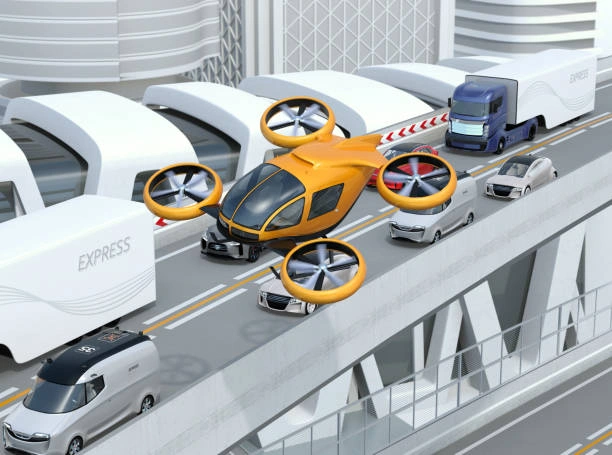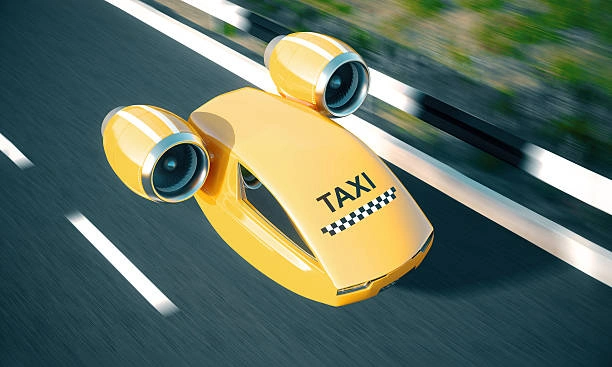Imagine soaring over traffic, gliding effortlessly through the air to your destination. This futuristic vision is rapidly becoming a reality as France takes a significant leap forward by approving a flying taxi port on a barge in the Seine River. For tech enthusiasts, this development is nothing short of exhilarating, marking a monumental step in urban mobility and innovation.
The Dawn of a New Era in Transportation
In recent years, the concept of flying taxis has transitioned from sci-fi fantasy to tangible reality. The approval of a flying taxi port along the iconic Seine River positions Paris at the forefront of this technological revolution. The port, situated on a barge, is set to become a bustling hub for aerial travel, revolutionizing the way people move around the city.
The integration of flying taxis into daily commuting underscores the growing need for innovative solutions to urban congestion. With traffic jams becoming increasingly problematic, the allure of bypassing ground-level bottlenecks is undeniable. The Seine River barge port represents a beacon of hope for more efficient, eco-friendly transportation options.
Paris as a Pioneering City
Paris, renowned for its historical landmarks and cultural richness, is now adding another feather to its cap. By approving the flying taxi port, the city is demonstrating its commitment to pushing the boundaries of technology. This initiative aligns seamlessly with Paris’s broader goals of sustainability, innovation, and enhancing the quality of urban life.
The port’s strategic location on the Seine River not only showcases Paris’s adaptability but also its readiness to integrate cutting-edge transportation solutions. By leveraging the river as a launchpad, the city minimizes the need for additional land-based infrastructure, making the project both practical and visionary.
How Flying Taxis Work
Flying taxis, also known as electric vertical takeoff and landing (eVTOL) aircraft, are designed to transport passengers quickly and efficiently through the air. These vehicles are equipped with advanced propulsion systems that allow them to take off and land vertically, similar to helicopters, but with quieter and more environmentally friendly operations.

The flying taxi port on the Seine River barge will serve as a central hub for these eVTOLs. Passengers can book their flights via an app, arrive at the port, and board their flying taxi for a swift, scenic ride to their destination. This seamless integration of technology and transportation is set to redefine urban mobility.
Environmental Impact and Sustainability
One of the most compelling aspects of flying taxis is their potential to significantly reduce carbon emissions. Unlike traditional vehicles that rely on fossil fuels, eVTOLs are powered by electricity, making them a greener alternative. The adoption of flying taxis aligns with global efforts to combat climate change and reduce our carbon footprint.
The flying taxi port on the Seine River barge further enhances sustainability by utilizing existing waterways for its operations. This approach minimizes disruption to the city’s infrastructure and preserves green spaces. By championing such eco-friendly initiatives, Paris is setting a precedent for other cities worldwide.
Advantages of Flying Taxis
Flying taxis offer numerous advantages over traditional transportation methods. Firstly, they greatly reduce travel time by avoiding traffic congestion and taking the most direct route to the destination. This efficiency is particularly beneficial for business professionals and tourists seeking to make the most of their time in the city.
Secondly, the flexibility of eVTOLs allows them to operate in various weather conditions and terrains, making them a reliable mode of transport. Whether it’s a sunny day or a drizzly evening, flying taxis can provide consistent service, ensuring passengers reach their destinations promptly.
Lastly, the comfort and convenience of flying taxis cannot be overstated. With spacious interiors, panoramic views, and smooth rides, passengers can enjoy a premium travel experience. This blend of luxury and practicality is set to make flying taxis a popular choice among commuters.
Challenges and Considerations
While the approval of the flying taxi port is a monumental achievement, it’s essential to acknowledge the challenges that lie ahead. Safety is paramount, and rigorous testing and regulations must be in place to ensure the wellbeing of passengers and the public. Developing air traffic control systems for urban air mobility is another critical aspect that requires attention.
Additionally, the cost of implementing and maintaining flying taxi infrastructure can be substantial. Governments, private companies, and stakeholders must collaborate to create sustainable financial models that support this innovative mode of transportation without burdening taxpayers.
The Future of Urban Mobility
The approval of the flying taxi port on the Seine River barge is indicative of a broader trend towards redefining urban mobility. Cities around the world are exploring similar initiatives, recognizing the potential of aerial transportation to alleviate congestion and enhance connectivity. The success of this project in Paris could serve as a blueprint for other metropolitan areas.
Innovations like flying taxis are paving the way for smart cities of the future, where technology seamlessly integrates with everyday life. The possibilities are endless, from autonomous delivery drones to air ambulances, heralding a new era of convenience and accessibility.
Public Reception and Community Engagement
Public opinion plays a crucial role in the successful implementation of flying taxis. Engaging with the community, addressing concerns, and highlighting the benefits are essential steps in gaining widespread acceptance. Educational campaigns, demonstrations, and pilot programs can help demystify the technology and build trust among residents.
The sense of community among tech enthusiasts and early adopters will also drive the success of the flying taxi initiative. By fostering a culture of innovation and collaboration, Paris can create a supportive environment for new technologies to thrive.
Economic Implications
The introduction of flying taxis has far-reaching economic implications. The development and operation of eVTOLs generate employment opportunities, from engineers and pilots to maintenance crews and customer service representatives. Additionally, the influx of tourists and business travelers utilizing flying taxis can boost local economies and support small businesses.
Investments in flying taxi infrastructure also signal confidence in the future of urban mobility, attracting further investment and innovation. Paris’s proactive approach positions it as a leader in the global tech landscape, inspiring other cities to follow suit.
The Role of Technology in Shaping Our Lives
The flying taxi port on the Seine River barge exemplifies how technology continues to shape and improve our lives. From smartphones to smart cities, advancements in technology are driving progress and opening new possibilities. The integration of flying taxis into urban transportation is just one example of how innovation can address real-world challenges and enhance our quality of life.
Tech enthusiasts have a unique opportunity to witness and contribute to these developments. By staying informed and engaged, they can play a pivotal role in shaping the future of transportation and beyond.
Looking Ahead
The approval of the flying taxi port on the Seine River barge marks the beginning of an exciting chapter in urban mobility. As the project progresses and flying taxis become a common sight in the skies of Paris, the potential for growth and expansion is limitless. Other cities will undoubtedly look to Paris as a model for integrating cutting-edge technology into their transportation networks.
For tech enthusiasts and innovators, this is a moment to celebrate and explore. The future of transportation is taking flight, and the possibilities are as vast as the skies above.
In conclusion, the approval of the flying taxi port on the Seine River barge is a groundbreaking achievement that positions Paris at the forefront of urban mobility innovation. Flying taxis offer numerous benefits, including reduced travel time, environmental sustainability, and enhanced convenience. However, successful implementation requires addressing safety concerns, engaging with the community, and developing robust infrastructure.
For tech enthusiasts, this development is a testament to the power of innovation and the endless possibilities it brings. By staying informed and involved, they can help shape the future of transportation and contribute to a more connected, efficient, and sustainable world.
Are you ready to witness the future of urban mobility? Stay tuned for more updates and join the conversation as flying taxis take flight in Paris and beyond.








